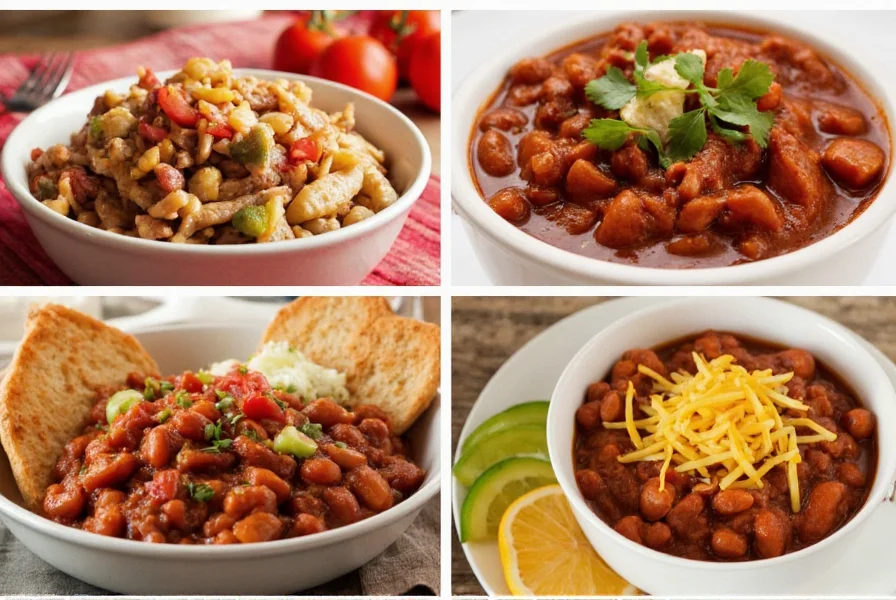For home cooks seeking the best chili con carne recipe, understanding its Texas roots is essential. Unlike common misconceptions, traditional chili con carne contains no beans—a point fiercely defended by Texas chili purists. This iconic dish evolved from Mexican chili con carne (chili with meat) brought north by immigrants in the 1800s, adapting to available ingredients and cowboy cooking methods.
The Foundation of Authentic Chili
Creating exceptional chili con carne starts with ingredient selection. The traditional texas chili con carne recipe relies on three pillars: quality meat, proper chili varieties, and slow cooking. Chuck roast or brisket provide ideal marbling that breaks down during the 3-4 hour simmer, while leaner cuts like sirloin can dry out. Dried ancho and guajillo peppers form the flavor base, supplemented by smoked paprika for depth without overwhelming heat.
| Essential Ingredients | Quantity | Preparation Notes |
|---|---|---|
| Beef chuck roast | 2 lbs | Cut into 1/2-inch cubes, fat partially trimmed |
| Dried ancho peppers | 4 | Stemmed, seeded, toasted 30 seconds per side |
| Yellow onion | 1 large | Fine dice for even distribution |
| Garlic | 4 cloves | Minced, added after onions soften |
| Ground cumin | 2 tbsp | Toast whole seeds then grind for best flavor |
Step-by-Step Cooking Process
The authentic chili con carne cooking technique separates amateurs from experts. Begin by searing meat in batches—crowding the pot creates steam instead of the Maillard reaction's flavor-building crust. After removing browned meat, toast whole dried peppers in a dry skillet until fragrant (about 30 seconds per side), then blend with 1 cup beef broth into a smooth paste. This method extracts maximum flavor while avoiding bitter notes from overcooked chili powder.
For the perfect chili con carne consistency, simmer uncovered for 3-4 hours after combining all ingredients. The stew should coat the back of a spoon without being paste-like. If it thickens too much, add broth 1/4 cup at a time. Skim excess fat during cooking for cleaner flavor. The acid balance is crucial—add 1 tablespoon of apple cider vinegar in the final 30 minutes to brighten rich flavors without making it taste sour.

Variations Worth Trying
While purists reject beans, the vegetarian chili con carne variation successfully substitutes textured vegetable protein (TVP) or portobello mushrooms for meat. For this adaptation, replace beef broth with mushroom stock and add 1 teaspoon cocoa powder to mimic meaty umami. Modern interpretations like Cincinnati-style chili incorporate chocolate and cinnamon, though these depart significantly from Texas tradition.
For those wondering how to make chili con carne less spicy, remove pepper seeds and membranes before toasting, and increase tomato content. The heat level should build gradually rather than assault the palate immediately. A dollop of sour cream or sprinkle of sharp cheddar when serving provides cooling contrast that enhances rather than masks the spices.
Serving and Storage Tips
Authentic Texas chili con carne shines when served simply with saltine crackers or cornbread—no cheese, onions, or other toppings that distract from the carefully balanced flavors. For optimal taste development, refrigerate overnight before serving; the chili con carne cooking time effectively continues as flavors meld. Properly stored in airtight containers, it maintains quality for 4 days refrigerated or 3 months frozen.

Frequently Asked Questions
What's the difference between chili and chili con carne?
Chili con carne specifically means "chili with meat" in Spanish and refers to the traditional meat-based stew. "Chili" alone often describes modern variations that may include beans or be vegetarian. Authentic Texas chili con carne contains no beans, while many regional chili recipes do.
Why does my chili con carne taste bland?
Bland chili usually results from insufficient layering of flavors. Key fixes include: toasting whole spices before grinding, using fresh garlic instead of powder, adding acid (like vinegar) at the end, and ensuring proper searing of meat. Dried chili peppers provide more complex flavor than pre-made chili powder alone.
Can I make chili con carne in a slow cooker?
Yes, but with modifications. Sear the meat and prepare the chili paste separately first, then transfer to slow cooker. Cook on low for 6-8 hours. Avoid cooking dried peppers directly in slow cooker as the prolonged heat makes them bitter. The slow cooker method works well for maintaining consistent temperature but requires careful spice timing.
How do I thicken chili con carne properly?
The best thickening method is reducing uncovered during the final hour of cooking. Alternatively, mix 1 tablespoon cornstarch with 2 tablespoons cold water and stir in during the last 15 minutes. Avoid flour which can create a pasty texture. Authentic chili con carne should coat a spoon but still flow slowly.











 浙公网安备
33010002000092号
浙公网安备
33010002000092号 浙B2-20120091-4
浙B2-20120091-4